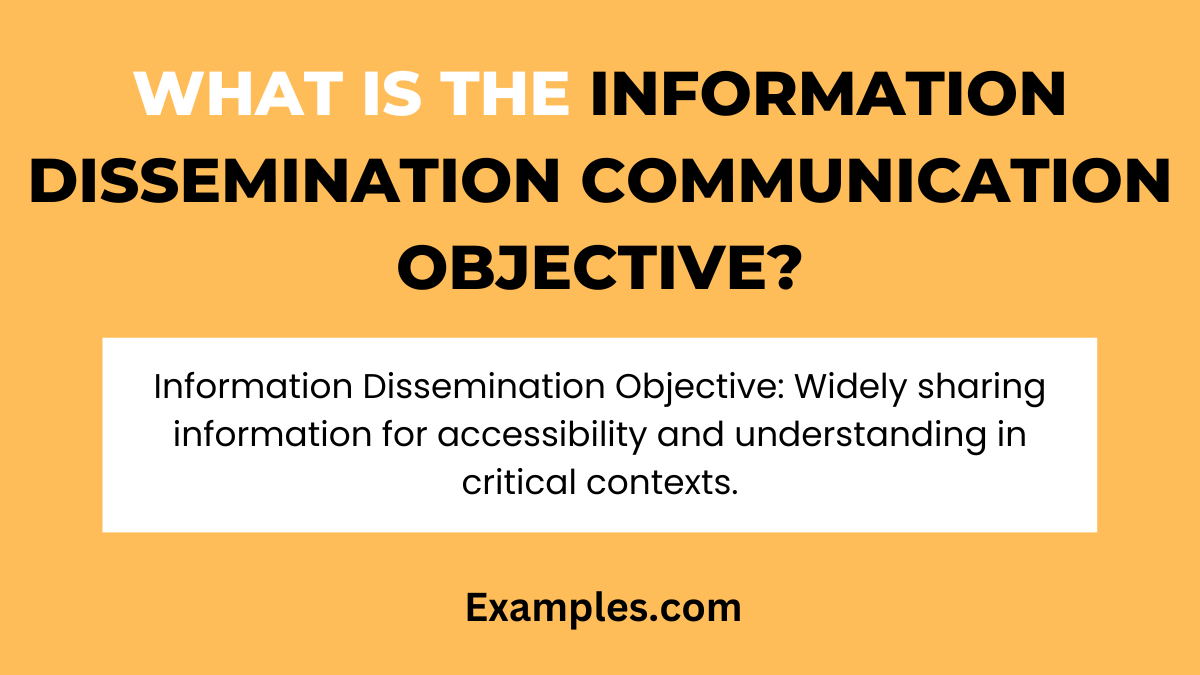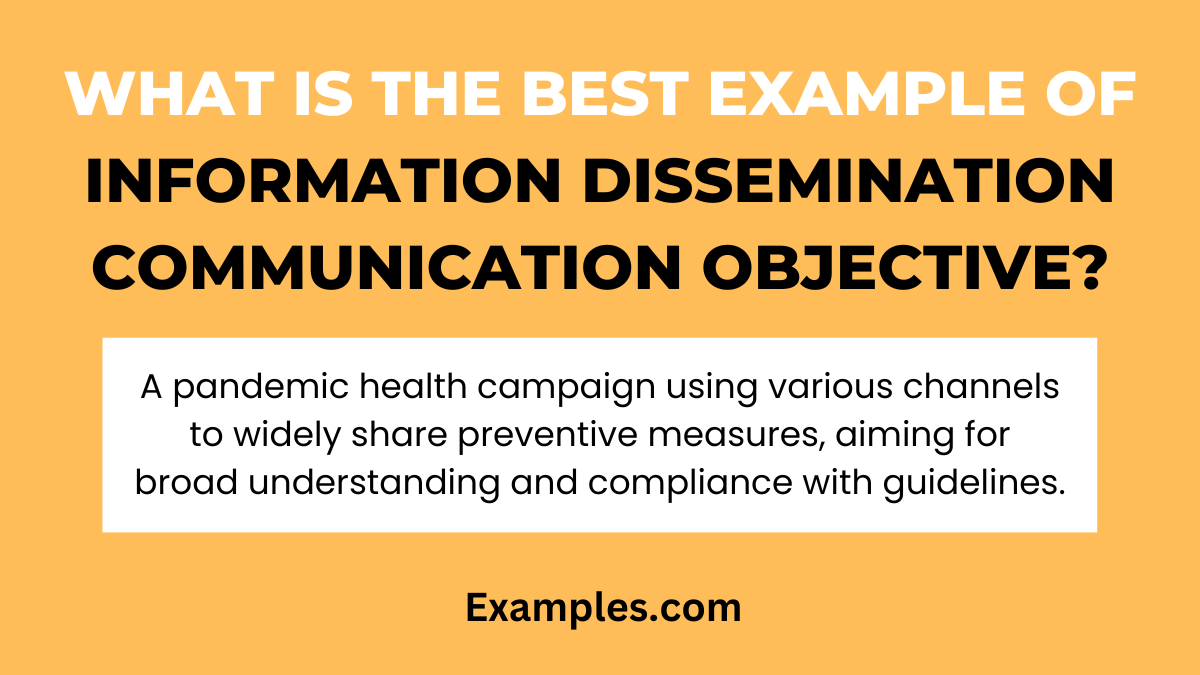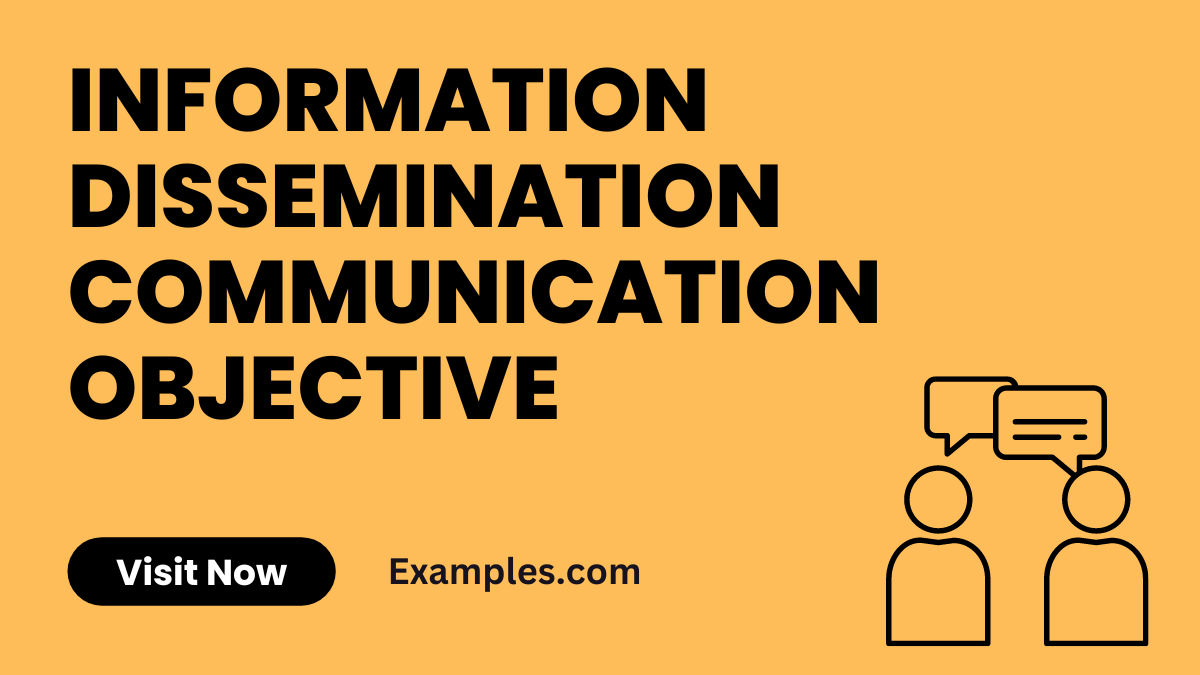19+ Information Dissemination Communication Objective Examples
The Information Dissemination Communication Objective is a crucial aspect of communication strategies, primarily focusing on distributing important information to a wide audience. This objective is essential in ensuring that relevant and timely information reaches the intended recipients efficiently and effectively. Whether in a business setting, educational context, or public awareness campaigns, mastering Communication Objectives for information dissemination can significantly impact the success of the intended message, ensuring it is received, understood, and acted upon by the target audience.
What is the Information Dissemination Communication Objective?

An Information Dissemination Communication Objective refers to the strategic goal of spreading information broadly to ensure that it reaches the appropriate audience. This objective involves identifying the right channels and methods to distribute information in a way that is accessible and understandable. It is particularly important in scenarios where timely and accurate information sharing is critical, such as public health advisories, educational content, or organizational updates.
What is the Best Example of Information Dissemination Communication Objective?

A prime example of an Information Dissemination Communication Objective is a public health campaign disseminating information about preventive health measures during a pandemic. The campaign uses various channels like social media, press releases, and public announcements to ensure the information reaches all segments of the population effectively. The objective is to ensure widespread understanding and adoption of health guidelines to protect public health.
20 Information Dissemination Communication Objective Examples

The Information Dissemination Communication Objective focuses on strategically sharing vital information to the right audience at the right time. These objectives are key in various contexts, from public health to business, education, and government. Effective information dissemination ensures that crucial information is not only communicated clearly but also reaches and influences the target audience, thereby aiding in decision-making, awareness, and behavior change.
- Public Health Guidelines Update: Informing the public about new health practices.
Example: “We need to effectively communicate the updated health guidelines to ensure public safety.” - Corporate Policy Changes to Employees: Sharing new company policies internally.
Example: “Let’s distribute an email detailing the new corporate policies to all employees.” - Education Curriculum Updates to Parents: Informing parents about changes in the school curriculum.
Example: “Our newsletter will explain the updated curriculum to parents.” - Product Recall Information to Customers: Quickly disseminating product recall details.
Example: “We must urgently communicate the recall information to ensure customer safety.” - Environmental Risk Alerts to Communities: Alerting communities about environmental hazards.
Example: “We need to use local media to spread awareness about the flood risks.” - Technology Upgrade Information to Users: Informing users about software updates or changes.
Example: “Our blog post will outline the steps for the new software update.” - Research Findings to Academic Community: Sharing new findings with scholars and researchers.
Example: “Let’s present our research findings at the upcoming academic conference.” - Emergency Procedures to Employees: Ensuring employees are aware of emergency protocols.
Example: “We’ll conduct a meeting to go over the new emergency procedures.” - Legal Requirement Changes to Industry Members: Updating industry members on new regulations.
Example: “Our webinar will cover the recent changes in industry regulations.” - Financial Reporting to Shareholders: Transparently communicating financial results to investors.
Example: “Our annual report will provide shareholders with a comprehensive financial overview.” - Nutritional Information to Consumers: Educating consumers about food product contents.
Example: “Labels should clearly display nutritional information for informed choices.” - Safety Training to Construction Workers: Providing updated safety training materials.
Example: “Let’s use video tutorials for our latest safety training.” - Voting Procedures to Citizens: Explaining election processes to the public.
Example: “Our campaign will focus on educating citizens about the new voting system.” - Market Analysis to Sales Team: Sharing market insights with the sales department.
Example: “Our monthly meeting will include a segment on recent market trends.” - Travel Advisories to Tourists: Issuing travel warnings or guidelines.
Example: “We should update our website with the latest travel advisories.” - Data Privacy Updates to Users: Communicating changes in data handling practices.
Example: “An email will be sent to users outlining our updated privacy policy.” - Community Event Details to Residents: Informing local residents about upcoming events.
Example: “We’ll use social media to announce the details of the community fair.” - Climate Change Facts to Students: Educating students on climate change issues.
Example: “Our interactive app will teach students about the impact of climate change.” - Energy Conservation Tips to Households: Promoting energy-saving practices among residents.
Example: “Our brochure will offer practical tips for conserving energy at home.” - Workshop Enrollment Information to Professionals: Advertising professional development opportunities.
Example: “Emails will be sent to professionals about our new skill development workshops.”
Information Dissemination Communication Objective in Marketing Research
In marketing research, the Information Dissemination Communication Objective plays a pivotal role in sharing research findings, market insights, and consumer behavior trends with relevant stakeholders. Effective dissemination of this information aids in strategic decision-making, product development, and overall marketing strategy formulation. This objective ensures that valuable research insights are not only communicated clearly but also reach the appropriate audience for maximum impact and utilization.
- Sharing Market Trends: Disseminating key trends to inform product and marketing strategies.
- Consumer Behavior Insights: Communicating findings on consumer preferences and behaviors.
- Competitive Analysis Results: Distributing insights about competitors to inform strategic planning.
- New Product Research Findings: Sharing research results related to new product development.
- Customer Satisfaction Surveys Outcomes: Communicating customer feedback to relevant departments.
- Brand Perception Studies: Disseminating information about how the brand is perceived in the market.
- Pricing Strategy Research: Sharing insights on optimal pricing strategies and consumer reactions.
- Advertising Effectiveness Analysis: Distributing results of advertising and campaign effectiveness studies.
- Distribution Channel Analysis: Communicating the effectiveness and reach of different distribution channels.
- Digital Marketing Analytics: Sharing insights from digital marketing campaigns to improve future strategies.
In marketing research, Information Dissemination is not just about broadcasting data; it’s about ensuring that the information is actionable, accessible, and effectively contributes to informed decision-making processes within the organization.
Types of Information Dissemination Communication Objective
In the field of communication, various Types of Information Dissemination Communication Objectives cater to different informational needs and audiences. These objectives are essential in ensuring that the right information reaches the right people at the right time, through appropriate channels.
- Public Awareness Campaigns: Aimed at educating the general public on significant issues.
- Internal Organizational Updates: Disseminating updates within an organization to employees.
- Educational Information Sharing: Distributing educational content to students or the public.
- Crisis Communication: Rapid dissemination of critical information during emergencies.
- Health and Safety Information: Spreading important health and safety guidelines.
- Research Findings Dissemination: Sharing new scientific or academic discoveries.
- Policy Changes and Legal Updates: Informing about new policies or legal requirements.
- Market and Industry Insights: Providing updates on market trends and industry news.
Each of these objectives requires a tailored approach to effectively reach and impact the intended audience.
Approaches to Information Dissemination Communication Objective
There are various Approaches to Information Dissemination Communication Objectives, each suited to different types of information and audiences. These approaches determine how information is packaged and delivered to ensure maximum reach and understanding.
- Multichannel Distribution: Using multiple platforms to reach diverse audiences.
- Targeted Messaging: Tailoring information to specific audience segments.
- Interactive Platforms: Encouraging audience engagement through interactive media.
- Visual and Multimedia Elements: Enhancing understanding through visuals and multimedia.
- Social Media Utilization: Leveraging social platforms for wide dissemination.
- Collaboration with Influencers and Partners: Expanding reach through partnerships.
- Feedback Mechanisms: Incorporating ways to gather audience feedback.
- Consistency in Messaging: Maintaining a consistent tone and message across channels.
Adopting the right approach is critical for effective information dissemination.
Importance of Information Dissemination Communication Objective
The Importance of Information Dissemination Communication Objective cannot be overstated. It plays a crucial role in ensuring that vital information effectively reaches and influences the target audience.
- Educating the Public: Essential for increasing public knowledge on important issues.
- Promoting Transparency: Builds trust through open sharing of information.
- Supporting Decision Making: Provides necessary information for informed decisions.
- Enhancing Public Safety: Crucial for disseminating safety and emergency information.
- Facilitating Change: Supports the adoption of new policies or practices.
- Encouraging Civic Engagement: Informs and motivates public participation.
- Strengthening Community Relations: Builds connections through shared information.
- Supporting Business Goals: Aids in achieving business objectives through informed strategies.
Effective information dissemination is key to achieving a range of communication objectives, making it a fundamental aspect of any communication strategy.
Information Dissemination Communication Objectives are vital for effectively sharing key information across various sectors. These objectives ensure that important messages reach and impact the intended audience, fostering informed decision-making and awareness. From public health to corporate settings and educational contexts, these objectives form the backbone of successful and meaningful communication efforts, enhancing knowledge and understanding among diverse audiences.



